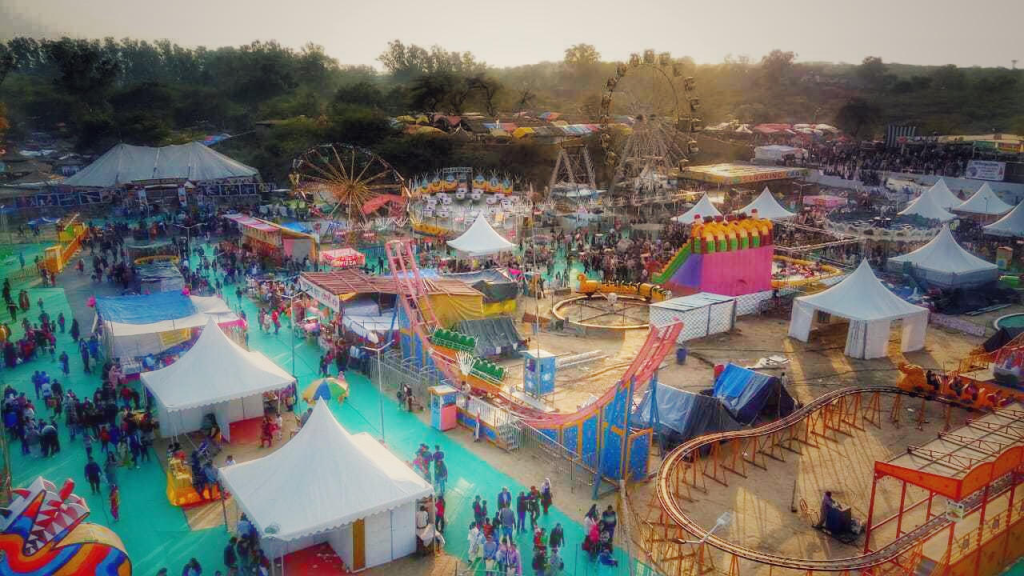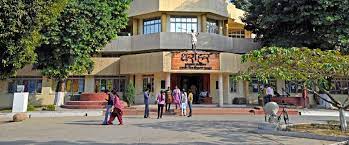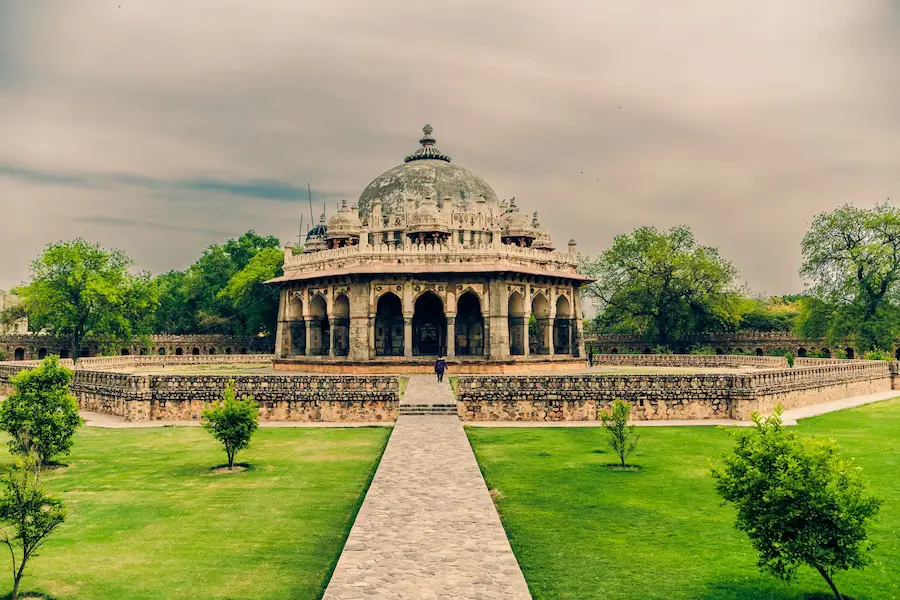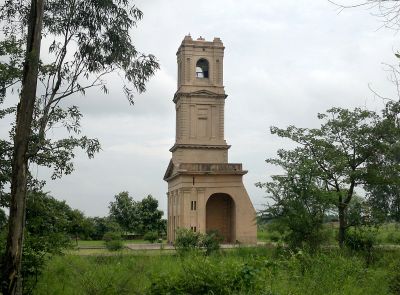Browse Items (64 total)
Sort by:
-
Birbal Ka Chhatta
This spacious building, built by Ray-i-Rayan Mukand Dass, the Diwan of Narnaul, during the reign of emperor Shah Jahan (1628-58 A.D.) is dexterously planned and embellished, though its exterior is unostentatious and drab. It is a five-storied structure with several halls, rooms and pavilions. The extensive open terrace on the south, elliptical pavillions on different levels, halls on pillars and running verandah around a central court, once adorned with a marble fountain, impart spaciousness and light to it. The profuse use of marble for veneering, pillars and brackets, provided with artificial cataracts and drains, make it a cosy retreat during the tropical summers.
In the south-eastern corner on the terrace, there is a dilapidated well, from which the water was raised into reservoirs, at various levels. An exquisite and isolated gateway-complex, well provided with projecting balconies and marble veneering stand a few metres to the west of the palace. This is said to have been the main entrance to the complex.
It said that Akbar and Birbal visited this town and that is why this structure Chhatta Rai Mukand Das is also popularly known as Chhatta of Birbal.
At a small distance from the Chhatta lies the Sarai Rai Mukand Das. The building bears an epigraph, which states that during the reign of Shah Jahan, Rai-Rayan Mukand Das, a servant of Nawab Asif Khan, built the lofty building under the super vision of Mehta Puran Mal Hari Dass. -
Bodh Stupa
It is a huge, high and round masonry Bodh stupa, constructed during ancient times. -
British Palace
It was called a bungalow, built for the residence of Superintendent of Hisar Cattle Farm. Later, the treasure from Kachahari building was shifted to this palace.
-
Bua Wala Talab
Years ago, there lived Mustafa Kalol, who enjoyed prestigious posts in Government; he had a beautiful and brave daughter named Bua. Once in a jungle, she encountered a tiger, a poor woodcutter Hasan helped her and took her back to the palace. She fell in love with brave and handsome Hasan. Even Bua’s father reluctantly approved of their marriage. Bua’s father sent Hasan to the battle field to fight as a soldier where he died. When Bua came to know about the sad news, she went to the pond where the lovers used to meet, with Hasan’s dead body, buried him there and built a tomb in the memory of her lover. After two years, Bua passed away, and she was buried beside Hasan’s tomb.
-
Cantonment Church Tower
In 1941, when the cantonment was shifted to Ambala, the church was dismantled. But the tower of the church built out of public contribution, was left standing. The tower has four storeys and on the first storey, Extruscan pilaster has been used structurally. The top storey has a semi-circular arch in Roman style. The entire exterior is plastered with lime and exhibits fine panelling work. -
Ch Devi Lal Herbal Nature Park
Situated in village Chuharpur on the Yamunanagar – Paonta road. In view of the increasing market demand for medicinal plants, both national and international and to exploit the commercial potential of medicinal resources of this region, Ch. Devi Lal Herbal Nature Park has been developed at Chuharpur in district Yamunanagar. It is instrumental in conservation and propagation of the resource base of medicinal plant material in Haryana. -
Chaneti Buddhist Stupa
The village Chaneti is about 3 kms. north-west of Sugh. During the reign of the Mauryan King Ashoka, the ancient city of Shrughna (modern Sugh) became an important center of Buddhism. As mentioned in the travel account of the Chinese pilgrim Yuan Chwang, this place was adorned by many stupas and a monastery. To construct this baked brick stupa, concentric layers were put one over the other, each time leaving some space on the underlying layer, so that the whole structure should give a hemispherical look. Thus, this stupa corresponds to the Shahpur and Dharmarajika stupas at Taxila. No trace of stone railing surrounding this stupa was found. Probably, it might have been wooden railings. At the top of the stupa, square space about 1.5 mt. was found filled with earth. This was the place for harmika (a small platform) which bore the chhatravali (umbrella). Four shrines in four directions near the old circumambulatory path (Pradakshina Path) were added to the stupa during Kushna Period and a new pathway was built below to walk around it. -
Chor Gumbad
At present, this complete hilly area has been developed in a park by the district administration. On account of prominent location of the Chor Gumbad, it is known as the landmark of Narnaul. It is a well-planned big size monument in square shape having single chamber with four minarets at each corner. It gives an appearance of a double-storied structure from the outside due to an open veranda running around it. This structure possibly came to be used as hideouts by thieves and highwaymen, subsequently leading probably to the popular present day name : Chor Gumbad. It was constructed by an Afghan Jamal Khan as his tomb. A low dome and arches show that it must have been constructed during the reign of Firoz Shah Tughlaq (1351-88 AD). At present, there is no grave inside the tomb. -
Dhamtan Sahib
Situated in Narwana tehsil, about 10 kms. east of Narwana on Narwana-Tohana road, Dhamtan It is believed that Rishi Valmiki had his ashram in Dharmsthan, and it was here that Lord Rama organised the Ashvamedha Yagya.
Also there is a Manji Sahib Gurudwara here and it is also believed that ninth Sikh Guru, Guru Tegh Bahadur, stayed here. The Gurudwara, which looks like a fort, was built in Guru’s memory.
-
Durgah Char Qutab
A group of monuments, situated to the west of the town are known as Durgah Char-Qutab. Jamal-ud-Din Hanswi (1187-1261 AD), Burhan-ud Din (1261-1303 AD), Qutab-ud-Din Munawwar (1300-1354 AD) and Nur-ud-Din or Nur-e-Jahan (1325-1397 AD) were the celebrated Sufi Saints of their times and designated as ‘Qutabs’. The dargah has been subjected to many changes. The tomb is connected to a small shed. It is said that it is built at the place where Baba Farid used to meditate and offer prayers. One of the most imposing edifices of this complex is the large mosque in the northern enclosure, which was constructed by Firoz Shah Tughlaq. Other important monuments in the complex include the tomb of Mir Ali, who was disciple of Jamal-ud-Din, the first Qutab and is said to have built this tomb for his teacher. But he himself was entombedhere due to his early demise. Also in the complex are the twin tombs of Begum Skinner and chhatries (two kiosks) known as Char Diwan and Ek Diwan.
















